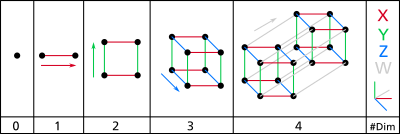
Back ቅጥ Amharic بعد Arabic Dimensión AST Арауыҡ үлсәнеше Bashkir Размернасць прасторы Byelorussian Pedelokan BEW Размерност Bulgarian মাত্রা Bengali/Bangla Dimensió Catalan ڕەھەند CKB


Dimensions are the way we see, measure and experience our world, by using up and down, right to left, back to front, hot and cold, how heavy and how long, as well as more advanced concepts from mathematics and physics. One way to define a dimension is to look at the degrees of freedom, or the way an object can move in a specific space. There are different concepts or ways where the term dimension is used, and there are also different definitions. There is no definition that can satisfy all concepts.
In a vector space (with vectors being "arrows" with directions), the dimension of , also written as ,[1] is equal to the cardinality (or number of vectors) of a basis of [2][3] (a set which indicates how many unique directions actually has). It is also equal to the number of the largest group of straight line directions of that space. "Normal" objects in everyday life are specified by three dimensions, which are usually called length, width and depth. Mathematicians call this concept Euclidean space.
Dimensions can be used to measure position too. The distance to a position from a starting place can be measured in the length, width and height directions. These distances are a measure of the position.
In some occasions, a fourth (4D) dimension, time, is used to show the position of an event in time and space.
- ↑ "Comprehensive List of Algebra Symbols". Math Vault. 2020-03-25. Retrieved 2020-09-07.
- ↑ Weisstein, Eric W. "Dimension". mathworld.wolfram.com. Retrieved 2020-09-07.
- ↑ "Basis and Dimension". people.math.carleton.ca. Archived from the original on 2021-12-21. Retrieved 2020-09-07.

